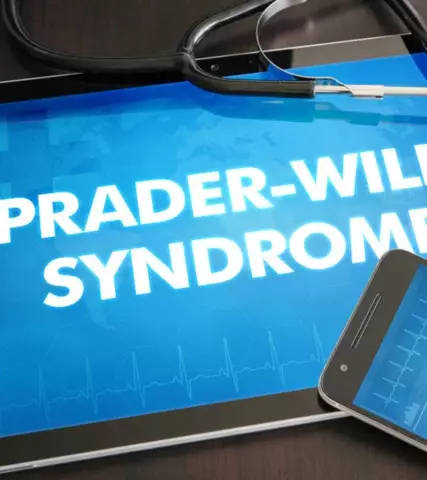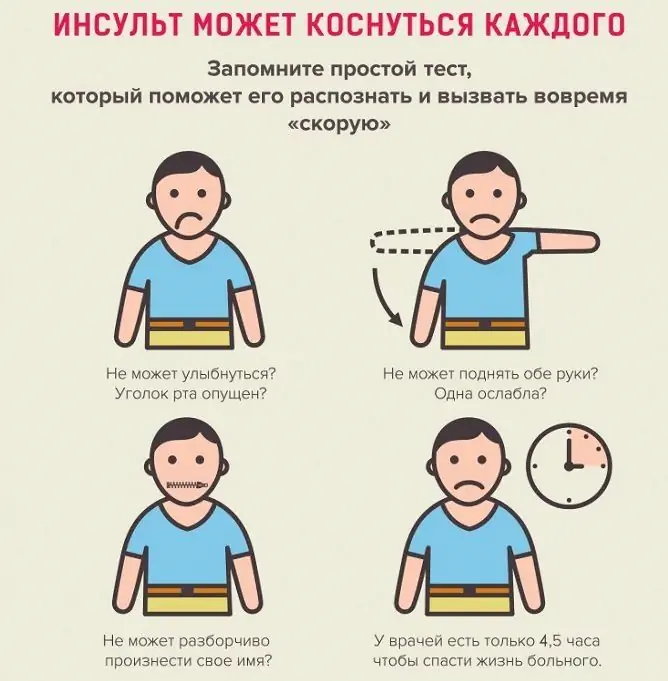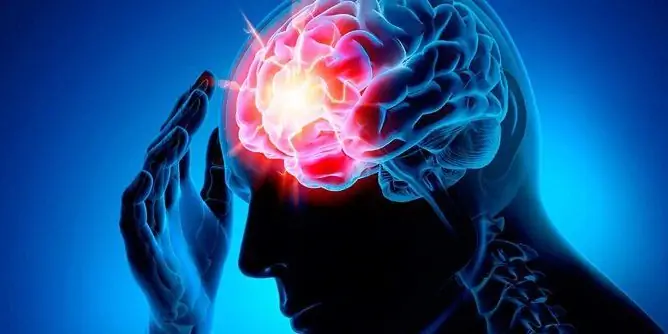- Author Rachel Wainwright [email protected].
- Public 2023-12-15 07:39.
- Last modified 2025-11-02 20:14.
Marfan syndrome
Marfan's syndrome (or arachnodactyly) is an inherited disorder characterized by a lack of connective tissue. The disease leads to pathological changes in the cardiovascular, nervous, musculoskeletal and other systems and organs.
Causes of Marfan syndrome

Arachnodactyly is inherited in an autosomal dominant manner, therefore it occurs in almost the same proportion in both men and women. This is a fairly rare genetic disease with a frequency of occurrence of 1: 5000.
Numerous studies have shown that Marfan syndrome is caused by a mutation in the 15th chromosome of the fibrillin protein gene, as a result of which the structure and production of collagen is disrupted.
According to statistics, in 75% of cases, the mutated gene is transmitted to children from sick parents, and in other cases, genetic mutations spontaneously arising at the time of conception lead to the disease.
The reasons for such "breakdowns" in genes have not been fully elucidated, but with a probability of 50% it can be argued that children born with Marfan syndrome will transmit this disease to their offspring.
Signs of Marfan syndrome
The most noticeable symptoms of the disease are external changes in a person's appearance. So, sick people are tall relative to their relatives. Another sign that is striking is the asthenic physique, in which the limbs are much longer, and there is also arachnodactyly, or "spider fingers". All people with this condition have an elongated skull, small jaw with malformed teeth, and deep-set eyes.
Usually, the signs of Marfan syndrome are divided into groups according to the organs and systems in which they appear. For example, tall stature and elongated limbs are manifestations of the musculoskeletal system. They also include curvature of the spine, chest deformity, joint softness, and flat feet.
Eye symptoms are lens clouding and dislocation (displacement from its natural location), myopia, retinal detachment and increased intraocular pressure.
The most dangerous signs of Marfan syndrome are symptoms related to the cardiovascular system. The disease leads to the stratification of the walls of the aorta and the expansion of its root, and this is fraught with an unexpected rupture of the main artery of the heart and an almost inevitable death. In addition, with Marfan's disease, sometimes there is a loose closure of the heart valves, which leads to an increase in heart size, murmurs, shortness of breath, and an irregular heartbeat.
The manifestations of pathology from the lungs, skin and nervous system are considered less serious.
Diagnostics of the Marfan syndrome
It is possible to diagnose Marfan syndrome only after a comprehensive examination by specialists of different profiles: a cardiologist, an orthopedist, an ophthalmologist and a geneticist.
A doctor who specializes in inherited disorders will look at the family history to identify those relatives who have died of cardiovascular disease.
The cardiologist will order a chest x-ray and a heart electrical activity (ECG) measurement. An echocardiogram is also needed to measure the aorta and check valve function.
An orthopedic surgeon will determine if there is a curvature of the chest and spine, flat feet, and other common problems.
Examination of the eyes by an ophthalmologist will detect pathological changes in the lens, if any.
The criteria for diagnosing Marfan's syndrome are quite strict and accurate. This is due to the fact that a number of features of the disease are typical (for example, not always a tall and thin person with long thin fingers is sick). In addition, there are other connective tissue diseases that are accompanied by similar symptoms.
The final diagnosis depends on the confirmation or refutation of arachnodactyly in the family history. If one of the relatives had this disease, confirmation in two body systems is enough, otherwise - in three.
Symptoms of the disease do not appear in early childhood, but are found only with age. Timely diagnosis of Marfan syndrome is very important, but even if the diagnosis is made for years, the symptoms can be treated even before the final verdict of the doctors.
Treatment for Marfan syndrome
To date, there are no effective treatments for Marfan syndrome. All measures are reduced to the prevention of complications of the disease.

To prevent dangerous aortic changes, the drug Anaprilin is prescribed, but its effectiveness has not been proven. Surgical repair of the aorta and heart valves is sometimes performed. Pregnant women with Marfan's disease and severe pathology of the cardiovascular system undergo a planned cesarean section. For the prevention of thrombosis and infective endocarditis after surgery, anticoagulants and antibiotics are prescribed.
With severe scoliosis, physiotherapy procedures are indicated, as well as mechanical strengthening of the skeleton. Surgical correction is performed if the angle of the spine deflection is 45 ° or more.
The life prognosis of people with Marfan syndrome depends primarily on the severity and degree of changes affecting the cardiovascular system. With rupture of the pulmonary trunk and aortic aneurysm, the patient dies in most cases.
Treatment of Marfan syndrome involves constant medical supervision and regular diagnostic examination. Physical activity of patients should be reduced to an average or low level, that is, sports competitions, contact sports, diving and isometric loads should be excluded. Women of childbearing age with this disease must undergo medical genetic counseling.
YouTube video related to the article:
The information is generalized and provided for informational purposes only. At the first sign of illness, see your doctor. Self-medication is hazardous to health!






